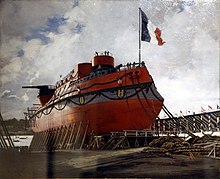Hoche (1886)
 Hoche po dokončení | |
| Základní údaje | |
|---|---|
| Typ | bitevní loď |
| Uživatelé | Francouzské námořnictvo |
| Jméno podle | Lazare Hoche |
| Zahájení stavby | červen 1881 |
| Spuštěna na vodu | září 1886 |
| Uvedena do služby | 1890 |
| Osud | 1913 potopena jako cvičný cíl |
| Předchůdce | třída Admiral Baudin |
| Následovník | třída Marceau |
| Takticko-technická data | |
| Výtlak | 10 820 t[1] |
| Délka | 102,59 m (na vodorysce) |
| Šířka | 20,22 m |
| Ponor | 8,31 m |
| Pohon | 8 kotlů, 4 parní stroje 2 lodní šrouby 12 000 hp |
| Palivo | uhlí |
| Rychlost | 16,5 uzlu |
| Dosah | 3000 nám. mil při 10 uzlech |
| Posádka | 611 |
| Pancíř | 250–450mm boky 400mm věže a barbety 100mm paluba 65mm velitelská věž |
| Výzbroj | 2× 340mm kanón (2×1) 2× 274mm kanón (2×1) 18× 139mm kanón (18×1) 10× 47mm kanón (10×1) 10× 37mm kanón (5hl.) 5× 380mm torpédomet |
Třída Hoche byla bitevní loď francouzského námořnictva. Představovala neobvyklý hybrid mezi věžovou a barbetovou lodí. Ve službě byla v letech 1890–1912. Dne 25. listopadu 1913 byla potopena jako cvičný cíl.[1]
Stavba

Plavidlo postavila francouzská loděnice Arsenal de Lorient v Lorientu. Kýl byl založen v červnu 1881, na vodu byla spuštěna v září 1886 a do služby byla přijata roku 1890.[1]
Konstrukce

Hlavní výzbroj kombinovala těžkou výzbroj dvou různých ráží, umístěnou zčásti v dělových věžích a zčásti v barbetách. Plavidlo mělo nízký volný bok a vysoké nástavby. Proto bylo přezdíváno „Grand Hotel“. Spaliny odváděly dva komíny. Dva stěžně byly osazeny marsy. Základem pancéřové ochrany byl boční pás ze sdruženého pancíře.[1] Dva 340mm/28 kanóny M1881 byly umístěna v dělových věžích na přídi a na zádi. Kvůli nim byla snížena příď a záď. Doplňovaly je dva 274mm/28 kanóny M1881 uložené v barbetách na bocích trupu. Sekundární výzbroj představovalo osmnáct 139mm kanónů M1881. Většina byla soustředěna do baterie sedmi hlavní, nacházející se na bocích v dolní části nástavby. Zbývající čtyři děla se nacházela o dvě paluby výš. Lehkou výzbroj představovalo deset 47mm/40 kanónů M1885 a deset 37mm pětihlavňových rotačních revolverových kanónů Hotchkiss. Výzbroj doplňovalo je pět 380mm torpédomety. Pohonný systém tvořilo osm kotlů a čtyři parní stroje o výkonu 12 000 hp, které poháněly dva lodní šrouby. Nejvyšší rychlost dosahovala 16,5 uzlu.[1] Dosah byl 3000 námořních mil při 10 uzlech.[2]
Modifikace
Ve službě plavidlo trpělo špatnou stabilitou. Roku 1898 prošlo modernizací, při které byly zmenšeny nástavby. Zároveň bylo instalováno šestnáct nových kotlů Belleville a dva nové parní stroje. Upraveno bylo i složení výzbroje. Standardní výtlak se zmenšil na 10 580 tun.[1]
Odkazy
Literatura
- HYNEK, Vladimír; KLUČINA, Petr. Válečné lodě 2: Mezi krymskou a rusko-japonskou válkou. Praha: Naše vojsko, 1986. S. 54.
Reference
Související články
Externí odkazy
 Obrázky, zvuky či videa k tématu Hoche na Wikimedia Commons
Obrázky, zvuky či videa k tématu Hoche na Wikimedia Commons
Média použitá na této stránce
Marine Nationale and French merchant ensign. Used from 1794 to 1814/1815, and from 1848 to present.
Notice that its proportions differ from those of the French civil flag. (ensign : 30:33:37, civil : 1/3,1/3,1/3)
The French ironclad Hoche soon after entering service. Původní popisek: „
Autor: Internet Archive Book Images, Licence: No restrictions
Identifier: railroadengineer65newy (find matches)
Title: The railroad and engineering journal
Year: 1887 (1880s)
Authors:
Subjects: Railroad engineering Engineering Railroads
Publisher: New York : M.N. Forney
Contributing Library: Carnegie Library of Pittsburgh
Digitizing Sponsor: Lyrasis Members and Sloan Foundation
View Book Page: Book Viewer
About This Book: Catalog Entry
View All Images: All Images From Book
Click here to view book online to see this illustration in context in a browseable online version of this book.
Text Appearing Before Image:
up toward it instead of away.The lower disk in Professor Williss apparatus, whenblown upon, moves against the current toward the upperdisk. Dr. Thomas Young proved, in 1800, that a certaincurved surface suspended by a thread approached animpinging air current, instead of receding from it. M.(joupil found, in experimenting, that a suspended hollowshape was first blown out to a horizontal position by awind of sufficient velocity, and then, when that velocityincreased, actually drew into the wind for an instant andslackened the tension on the cord. It is also said that cer-tain forms of windmills wear more on the front stop thanon the back stop of their axle of rotation ; so that thereseems to be a mysterious action, which some French ob-servers, who have been watching birds soar, have, forwant of a better term, called their Aspiration, by whicha body acted upon by a current may actually draw for-ward into that current against its direction of motion. 464 THE RAILROAD AND (October, 1891.
Text Appearing After Image:
>> z X uz u OS m XH OSo X o o X X</) _)Hf- < Vol. LXV, Ko. 10.) ENGINEERING JOURNAL. 465 Thus it is seen that in such complicated matters theorycannot progress in advance of experiment, and theextreme importance of those experiments hitherto tried,or hereafter to be tried by a physicist possessing theability of Professor Langley, will in part be appreci-ated. Science has been awaiting the great physicist, who, likeGalileo or Newton, should bring order out of chaos inaerodynamics, and reduce its many anomalies to the ruleof harmonious law. It is not impossible that when thatlaw is formulated all the discrepancies and apparentanomalies which now appear, will be found easily ex-plained and accounted for by one simple general cause,which has been hitherto overlooked. Thus far, Professor Langley seems to have experimentedupon plane surfaces only, and to have measured chieflywhat has been termed in the table here given the liftand the drift at various angles. His conclusionsther
Note About Images



